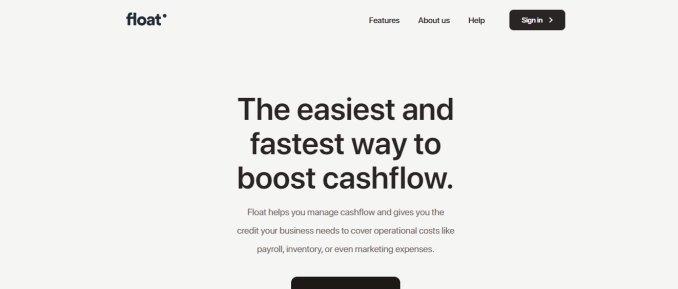According to research, 85% of African SMBs have zero access to financing, and each day, African SMBs have billions locked up in receivables due to long payment cycles. This leads to cash flow problems that cause businesses to be late on important expenses and fulfilment of new orders.
Jesse Ghansah and his co-founder Barima Effah want to answer these problems with their newly launched startup Float.
Ghansah is a serial entrepreneur. Since leaving the university in 2014, he has co-founded several tech startups but made his mark globally with OMG Digital, a startup with offices in Ghana and Nigeria that wanted to become the “BuzzFeed of Africa.” In 2016, OMG Digital was one of the first African companies accepted into Y Combinator.
Ghansah had a good run with the company and left two years ago. For his newest venture, he turned his focus outside media to fintech. Formerly Swipe, Float is an 18-month-old Lagos and San Francisco-based company aiming to close the $300 billion liquidity gap for Africa’s small and medium businesses. The company took part in YC’s Winter batch 2020, making Ghansah one of the few two-time YC founders in Africa.
Float has evolved from the last time we partly covered them during their Demo Day as “Brex for Africa.” According to CEO Ghansah, Float is “rethinking the way African businesses manage their financial operations, from managing cash and making payments to accessing credit.”
After 18 months in stealth, Float is finally going live, and we spoke with the CEO to get a glimpse into its progress and what makes it different from similar platforms on the continent.
TC: What problem would you say Float is solving?
JG: If you ask any small business, cash flow will most likely be the number one problem that they face. And this stems from the whole payment cycle, which is after you provide a service or deliver a product. Businesses that serve other businesses have to wait typically for 30-90 days for their payments to come in. This is like a traditional payment cycle where you have to offer credit sales to your customers to stay competitive; that’s why you send an invoice, and the customer will pay you back within that time frame.
That creates a lot of problems in terms of constant cash crunches. Because you’re waiting for your revenue to come in, they sometimes fall behind in meeting certain expense payments like payroll, inventory, utilities. That’s what really causes a lot of these cash flow issues, and because of that, businesses can’t grow. For existing businesses, these are the issues they face and getting credit in terms of working capital is extremely difficult if you’re dealing with banks.
TC: Did you have a personal experience with this problem seeing as your past venture was in media?
JG: As you know, I was a co-founder at OMG Digital, and as a media company, we had to wait for months to get paid by our partners. We needed credit this time and proceeded to get an overdraft from a long-term partner bank where we had transacted more than $100,000. But the bank wanted us to deposit 100% collateral in cash before they could give the overdraft.
I also remember taking money from loan sharks with ridiculous interest rates, sometimes as high as 20% a month, just to meet payroll. That sort of threw me into solving those problems with Float.
TC: There are a plethora of lenders giving loans to businesses. How is Float solving the credit issue differently?
JG: So our credit product is quite different regarding how we present it to the customer. It is less complex than a loan; it is more flexible than a business overdraft. Also, there’s a difference in the tools that we provide. So we don’t just give money; what we’ve provided is a software solution with credit embedded.

Right now, we’ve built what we call the cash management tool for businesses where they get credit at the critical set of moments in time. For instance, if you want to pay a lender and need credit, you can withdraw the credit and make payment immediately. We provide a credit line that businesses can tap into any time they want as soon as they onboard to our platform, and it increases and decreases based on the transactions performed on our platform.
So that’s just on the credit side. We’ve also built tools to help businesses stay on top of their cash flow. We give them invoicing, budgeting tools and spend management tools and a way for them to manage all their bank accounts because we know that existing businesses usually have more than one bank account. On Float, they can see all their balances and transactions, and we’re building a way for these businesses to make payments from their accounts on Float.
You can think of Float as a really well-built cash management platform. You get credit when you need it to make vendor payments or boost your working capital, which has been pivotal to our loss rate of 0%. Then two, tools that give total visibility about your businesses so you know where your money is coming in and going out.
TC: Float’s loss rate is 0%? Does that mean no business has defaulted on your platform?
JG: Yes, we’ve not had any default so far. We’ve advanced $2.8 million to our pilot customers in Nigeria, and we don’t have any losses in the last eight months; it’s because of the type of loans we’re giving. We give businesses money to boost their working capital. So we’re essentially giving you an advance for your future revenue.
If you look like, in the U.S., Pipe has built this for SaaS companies and are building for other customer segments, which is essentially what we’re doing. So, for us, the way we’re solving the cash flow issue is that we’re sorting your future revenue and as your customers pay you through our platform, then we make deductions.
You can think of us as a Stripe Capital, Square Capital, Pipe or the new multidimensional lending platforms we have now. When you consider lending, I’d say there are different phases. Lending 1.0 was when you’d fill an application online, and you’d get a loan decision. Lending 2.0 and 3.0 is where credit is embedded in online tools businesses already use. That’s why it has worked really well because the businesses on our platform aren’t exactly looking for a lifeline but are looking to boost their cash flow and basically step on the gas to grow.
TC: But this loss rate will likely change as soon as you onboard more businesses, right?
JG: Yes, definitely it’s going to change. The thing with lending is that with more customers, your credit model gets tested. The more customers you have, the more probability that you’re going to have default losses. But as long as you have, like a solid credit risk criteria and assessment, you must always try to keep it as small as possible. It’s almost impossible to have a 0% default rate when you begin to grow fast.
TC: What strategy does Float put in place to mitigate losses and reduce risk?
JG: The way our credit product works is that we’re constantly connected to your bank; we know who your vendors are, know who your suppliers are, and know who your customers are. We know how much money is flowing in and out of your business at any point in time. So as I mentioned, we can quickly adjust your credit limits as soon as we sense a difference in your activity. If we notice your invoice activity has dropped and we’re not receiving as much money as you were in the previous weeks, we reduce your limit. It’s a very dynamic sort of type of product, and it is really different from what you see out there today.
TC: Aside from lending, how have the other tools been helpful to businesses?
JG: With our pilot phase, we’ve been able to give credit and also processed invoicing and vendor payments for our customers worth about $5 million.
When you think of business payments, sometimes people always think about Paystack and Flutterwave. They’re tackling a different segment which is basically consumers paying businesses. For us, we’re centred around businesses paying other businesses. Their method, as we know, is a very drawn-out process, and that market is 10 times bigger than the market Paystack and Flutterwave are serving.

L-R: Barima Effah and Jesse Ghansah
If you look at your big multinational corporations, they have thousands of vendors on their payroll every month. Globally trillions of dollars are flowing from business to business, and that is where we want to play in. We’re launching the new version of our invoicing product and vendor payments, and a product where we can pay for services upfront on behalf of our customers and they pay back in 30 days.
TC: I’m tempted to call Float a digital bank for small businesses. Would you say there are differences?
JG: Of course there are. Almost any business owner will tell you that business banking is mostly broken. Legacy banks typically provide an outdated, underwhelming user experience. Businesses quickly move beyond basic banking needs, and for them, the options are frustratingly limited.
African neo-banks are aiming to compete with traditional banks. Still, in reality, they are actually now competing with each other for a relatively tiny slice of the market due to not solving the core problems facing businesses. A marginally better UX and a quick account opening experience is the value proposition that probably resonates well with a new startup business or a budding freelancer. However, to an already operating retail business owner that struggles to make timely payments to suppliers due to poor cash flow, that’s grossly inadequate.
This, coupled with the trust matters, reconciliation, and auditing headaches involved in moving accounts, is why neobanks haven’t taken off in this market.
There are little to no switching costs using Float because we have designed our platform to run on top of existing business bank accounts and payment processors. The idea is to provide a single platform that provides businesses with the credit they need, a consolidated view of their existing business banking and cashflow activity, coupled with various payment tools to enable them to speed through their financial operations so they can spend more time actually growing their business.

